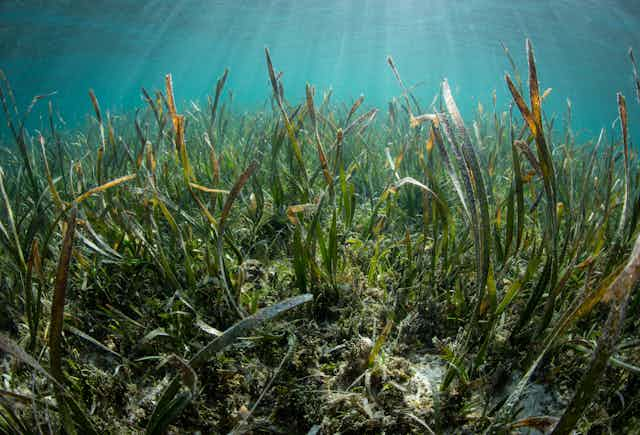Despite being less famous than other marine ecosystems like mangroves and coral reefs, seagrass meadows are one of the crucial areas in coastal waters, due to their important role as food sources for marine animals and carbon storage.
Similar to mangroves and coral reefs, yet different from seaweeds, seagrass ecosystems are silently struggling with degradation caused by human activities.
The culprits are coastal reclamation and development, oil pollution, sand and coral mining, seaweed farming, sedimentation, deforestation, overfishing, poor water quality, and garbage. Human activities in collecting small animals such as molluscs and sea cucumbers from seagrass during low tides can also be a threat.
Read more: Seagrass is a marine powerhouse, so why isn't it on the world's conservation agenda?
The above activities can remove 2-5% of the total of seagrass area per year globally.
Local communities and the government have made efforts to protect seagrass. In some coastal communities in eastern Indonesia, fishermen enacted a fishing moratorium, locally known as “sasi”.
Nationally, the government has created Marine Protected Areas (MPAs) across the archipelago, which currently covered at least 20 million hectares.
Some marine protected areas, such as in Wakatobi island and Buton regency in Southeast Sulawesi province, have been successful in increasing the seagrass cover in those areas.
However, there are also unhappy stories, like in North Nias, North Sumatra and Biak Numfor, Papua. These areas can’t stop seagrass cover from declining further.
In those areas, seagrass cover has declined from 58 to 48% and 61 to 55% of the average value from several sites in each area from 2016 to 2017, respectively.
Here is my analysis why seagrass ecosystem in protected areas still under threat.
What are lacking from Marine Protected Areas (MPAs)?
Marine protected areas (MPAs) are not necessarily effective in managing programs to protect seagrass as it failed to predict threats when they are designed.
Majority of threats to the marine ecosystem come from outside of the protected areas, for instance sedimentation from runoffs resulted from coastal development and rapid population growth.
Read more: No-take marine areas help fishers (and fish) far more than we thought
Other issues, pollutants and debris (such as plastic) to fisheries activities also harm seagrass ecosystem. Fishing activities, at a certain level, could damage seagrass. Anchors, propellers, and fishing gears often cut the leaves or uprooted the whole plant.

Lack awareness and knowledge from MPAs authorities complicates the effort to protect seagrass ecosystem.
This resulted to managers of MPAs with insufficient knowledge to construct effective conservation management program for seagrass ecosystem.
Why seagrass ecosystem is important?
Seagrass is home to marine animals, both for endangered animals (such as dugong, sea turtle, seahorse, tiger shark) and economically targeted animals (such as snappers and emperor fishes, sea cucumber, molluscs, crabs).

While feeding marine creatures, the plants, also act as carbon sinks. Through photosynthesis, they take in carbon dioxide from the environment and transform it into biomass in their organs (roots, rhizomes, and leaves) that will be eaten by other marine animals. The unconsumed organ, eventually will shed and decomposed in the sediment.
This means that seagrass meadows are taking part in climate change mitigation as they have the ability to sequester carbon from the environment.
What should be done?
To address the lack of protected areas to protect seagrass, I suggest these steps for the MPA’s administrator (either the government or the local communities):
First, improve the inefficiency of MPAs by careful planning and regular monitoring. The monitoring should cover threats coming from outside of protected areas.
MPA should monitor water quality on regular basis to provide information of possible sediment and pollutants harmful to seagrass as early as possible. That way, they can prevent further damage to happen.
Second, improve people’s awareness of the issues by creating public campaigns. The campaigns should increase knowledge about the importance of seagrass ecosystem via mainstream media, social media to education.
One of the success stories of effective MPA administrators is Wakatobi National Park. Its received support from international NGOs, such as WWF and TNC, to develop programs protecting the national park.

Local people then managed to continue the projects, involving local communities and NGOs, such as Forum Kahedupa Toudani (Forkani), to protect the ecosystem.
Besides these two approaches, there’s a third approach involving communities living inside and around the protected areas, as human activities contribute greatly to seagrass ecosystem degradation.
We must engage with local people in marine protected areas and encourage them to get involved in seagrass ecosystem protection.
For instance, we can encourage them to enforce a temporary fishing moratorium in seagrass areas.
Other example is to implement environmentally friendly aquaculture, such as seaweed farming. This could provide alternative income for the communities and reduce the exploitation of natural resource in the seagrass bed.
Wakatobi National Park has given good examples of monitoring coastal ecosystem. It also managed to raise public awareness and engage with the local communities to protect the coastal ecosystem.
However, their activities are possible with the help from from many NGOs and scientific projects. But this support may have expiration dates, therefore, we hope that the MPA managers and local NGOs are capable to continue the protection.
Although existing protections for seagrass in Indonesia are still ineffective, these efforts are still a good start. Little protection is still better than none.


